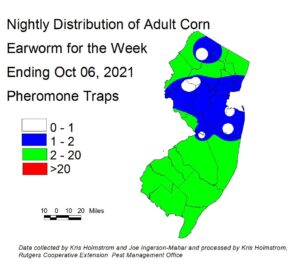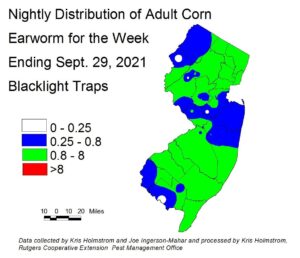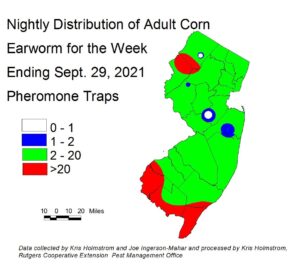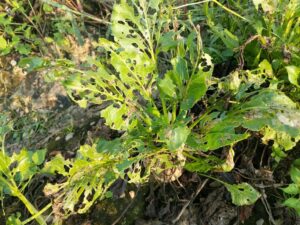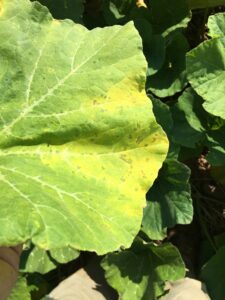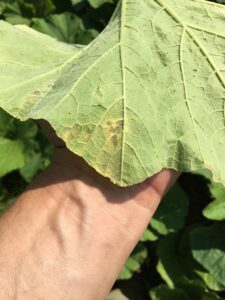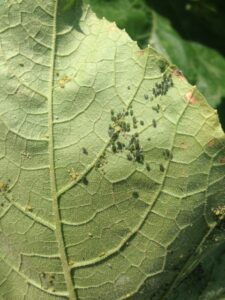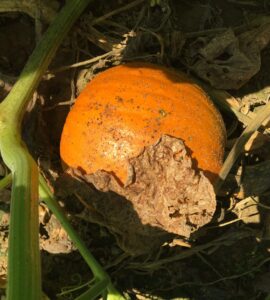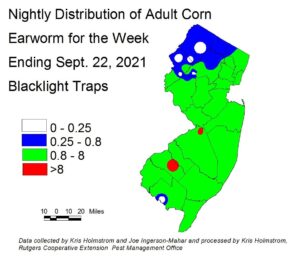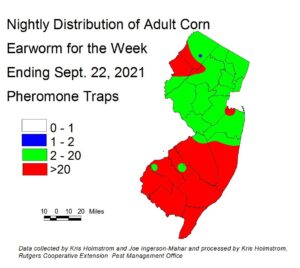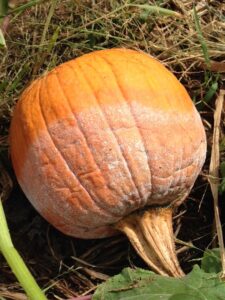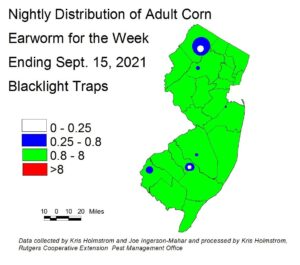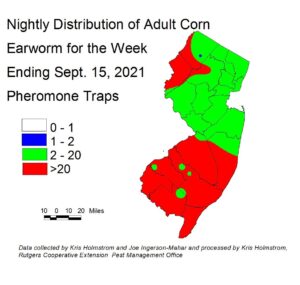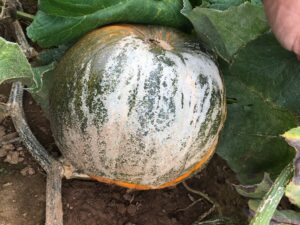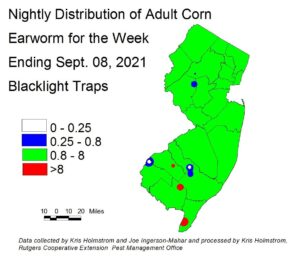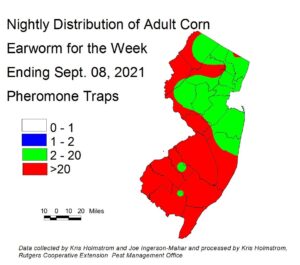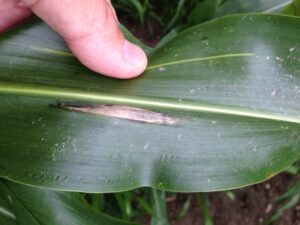Note: This is the final scheduled edition of the Vegetable IPM Update for 2021.
Sweet Corn
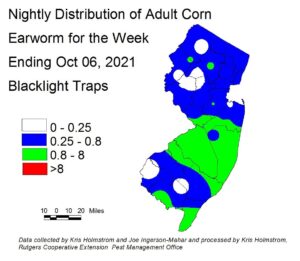 Corn earworm (CEW) moth captures from both trap types continue to decline with low evening temperatures, although the population still poses a threat to remaining sweet corn. It is likely that CEW activity will rise and fall with evening temperatures for the next several weeks. Both trap types throughout the state are generally in agreement as to spray schedules (see below). The number of pheromone traps deployed is much lower, resulting in much broader color bands on the map. It is also important to understand that pheromone traps are more sensitive than blacklight traps, and thresholds are adjusted to account for the higher catches typical of this trap type. On the blacklight map (left), green areas represent a 3-day silk spray schedule, while blue areas on the blacklight map should be represent 4-day schedules. On the pheromone map (below right), red represents a 3 day spray schedule. Green areas on the pheromone map represent a 4-day schedule.
Corn earworm (CEW) moth captures from both trap types continue to decline with low evening temperatures, although the population still poses a threat to remaining sweet corn. It is likely that CEW activity will rise and fall with evening temperatures for the next several weeks. Both trap types throughout the state are generally in agreement as to spray schedules (see below). The number of pheromone traps deployed is much lower, resulting in much broader color bands on the map. It is also important to understand that pheromone traps are more sensitive than blacklight traps, and thresholds are adjusted to account for the higher catches typical of this trap type. On the blacklight map (left), green areas represent a 3-day silk spray schedule, while blue areas on the blacklight map should be represent 4-day schedules. On the pheromone map (below right), red represents a 3 day spray schedule. Green areas on the pheromone map represent a 4-day schedule.
The highest nightly blacklight trap catches of CEW for the week ending 10/06/21 are as follows:
| Crosswicks 6 | Tabernacle 2 | Milltown 1 |
| Downer 2 | Bellemeade 1 | Pennington 1 |
| Georgetown 2 | Green Creek 1 | Princeton 1 |
| Medford 2 | Jones Island 1 | Sergeantsville 1 |
The highest nightly pheromone trap catches of CEW for the week ending 10/06/21 are as follows:
| Woodstown 15 | Tabernacle 12 | Dayton 3 |
| Green Creek 14 | Allamuchy 10 | Snyder Farm (Hunterdon) 2 |
| Monroeville 13 | Berlin 8 | South Branch 2 |
| Tabernacle 12 | East Vineland 8 | Springdale 2 |
Silking Spray Schedules*:
South – 3-4 days
Central – 3-4 days
North – 3 -4 days
*These recommendations are based on regional catches. Adhere to tighter spray schedules if indicated by local trap catches. Synthetic pyrethroids alone should NOT be used for corn earworm (CEW) protection on silking corn, or for fall armyworm (FAW) management at any stage. Control with these materials is very inconsistent. Utilize materials in IRAC groups 5 and 28, or combination products that include IRAC group 28 for best control. See the Sweet Corn section of the 2020-21 Commercial Vegetable Production Guide for selections.
Cole Crops
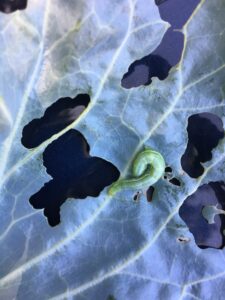 Fall plantings of cole crops continue to be infested by imported cabbageworm (ICW) and diamondback moth (DBM) larvae. With DBM being the most destructive larval type at this time. Cabbage looper (CL-photo at left), cross striped cabbage worm (CSCW-photo at right) and beet armyworm (BAW) see note below)) are also causing
Fall plantings of cole crops continue to be infested by imported cabbageworm (ICW) and diamondback moth (DBM) larvae. With DBM being the most destructive larval type at this time. Cabbage looper (CL-photo at left), cross striped cabbage worm (CSCW-photo at right) and beet armyworm (BAW) see note below)) are also causing injury to these crops, with CSCW becoming more common.
injury to these crops, with CSCW becoming more common.
Check 5 consecutive plants each in 10 random locations throughout the planting. Consider treating if caterpillars are found on 10% or more plants that are in the 0-9 true leaf stage. From 9-leaf to the early head stage (in broccoli, cauliflower, and cabbage) infestations up to 20% may be tolerated. Once heads begin to form, a 5% threshold should be observed to protect the marketable portion of the plant. For leafy greens such as collards and kale, 10% plants infested is the threshold throughout.
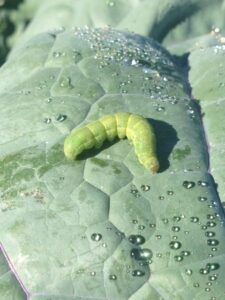 Some populations of DBM are resistant to carbamate and synthetic pyrethroid insecticides. The lack of DBM control with these insecticides has been noted in NJ previously. It is important to distinguish between common cole crop pests for this reason. DBM larvae grow to a length of approximately 0.5”, and taper toward both ends (see photo at right). These caterpillars thrash violently when disturbed. Newer chemistries that specifically target caterpillar pests are effective against DBM as well as all other caterpillar pests of cole crops, including BAW (see photo at left), another species with exhibiting pyrethroid resistance. These materials include (active ingredient – trade name (IRAC* code)):
Some populations of DBM are resistant to carbamate and synthetic pyrethroid insecticides. The lack of DBM control with these insecticides has been noted in NJ previously. It is important to distinguish between common cole crop pests for this reason. DBM larvae grow to a length of approximately 0.5”, and taper toward both ends (see photo at right). These caterpillars thrash violently when disturbed. Newer chemistries that specifically target caterpillar pests are effective against DBM as well as all other caterpillar pests of cole crops, including BAW (see photo at left), another species with exhibiting pyrethroid resistance. These materials include (active ingredient – trade name (IRAC* code)):
Spinosad/Spinetoram – Entrust(OMRI)/ Radiant (5)
Chlorantraniliprole – Coragen (28)
Cyantraniliprole – Exirel (28)
Peppers
Pepper weevil –
No additional farms have been reported as being infested. Currently infested farms are not actively trying to manage the weevil due to the lateness of the season.
A new fact sheet is now available for anyone interested in monitoring for pepper weevils on their own: FS1330: Monitoring and Management of Pepper Weevil in New Jersey (Rutgers NJAES).
Beet armyworm (BAW) captures are fairly low in southern NJ pheromone traps, with the exception of very high catches in the East Vineland area. This pest can attack peppers, and growers and scouts should check for the presence of heavily damaged leaves near terminal growth on pepper plants. BAW larvae will be found in the area of damage. As yet, no injury to peppers has been reported, but BAW are appearing in a number of areas on cole crops and other leafy greens such as chard and beets. Spinach is also a host for this pest, and all of these crops should be inspected regularly for the presence of larvae and feeding.
The highest nightly pheromone trap catches of BAW for the week ending 10/06/21 are as follows:
| East Vineland 95 | Jones Island 3 |
| Folsom 7 | Woodstown 2 |
Allium Leaf Miner
Allium leaf miner (ALM) adults are active now, and adults and injury have been observed on leeks in Hunterdon County. ALM should be considered a threat to late alliums in all parts of the state at this time.
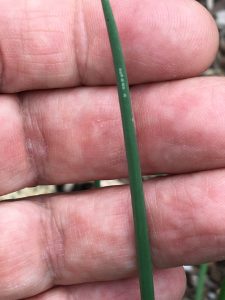 Growers should consider initiating (continuing) the control method of their choice at this time. Affected crops include chives, scallions, garlic, onions and leeks. Look for neat rows of white spots descending from the upper tips of allium leaves (see photo at left). Initial injury often occurs on the tallest leaves. Under warmer, less breezy conditions, adults may be seen near the tips of leaves (see photo of adults at lower right). Click on photos to enlarge the images.
Growers should consider initiating (continuing) the control method of their choice at this time. Affected crops include chives, scallions, garlic, onions and leeks. Look for neat rows of white spots descending from the upper tips of allium leaves (see photo at left). Initial injury often occurs on the tallest leaves. Under warmer, less breezy conditions, adults may be seen near the tips of leaves (see photo of adults at lower right). Click on photos to enlarge the images.
Floating row covers, kept on until this flight ends will help minimize access to plants. Insecticide applications targeting adults may be helpful as well, although weekly sprays may not completely eliminate foliar injury. Spinosyn materials (Radiant, Entrust (OMRI approved)), pyrethroids (Mustang Maxx, Warrior), neonicotinoids (Scorpion, Venom), the diamide Exirel (section 2ee recommendation) and the insect growth regulator Trigard are labeled for leaf miner control.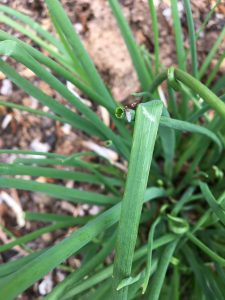
Adult activity and observations of feeding will be reported on in the IPM Update as they occur. At this time, all growers should respond to the second adult generation.
Thank you!!
Once again, Kris Holmstrom and Joe Ingerson-Mahar would like to acknowledge the IPM Field Technicians for this season:
Rhea Bolar
Claire Chapeau
Jeff Kane
Jake Newcombe
Gabriel Torres
Without the assistance of these individuals, much of the information presented in this publication would have been unobtainable. We are grateful for all their help and hard work.
